Understanding Dog's Body Language
A Comprehensive Guide
Step into the captivating world of canine communication as we unravel the subtle yet powerful language of our four-legged friends.
Understanding a dog’s body language is like peering into their soul, deciphering their emotions, and strengthening the unspoken bond we share.
Join us on a journey to decode tail wags, paw gestures, and facial expressions, ensuring a deeper connection with your beloved furry companion.
Get ready to bridge the communication gap and embark on an enriching adventure in the fascinating realm of dog behavior.
Synopsis – Understanding Dog Body Language
Tail Wagging
Decode the language of tails!
Discover what different wagging patterns reveal about your dog’s emotions.
Ear Positioning:
Ears speak volumes!
Learn how your dog’s ear movements can provide insights into their mood and feelings.
Facial Expressions:
Faces tell stories!
Delve into the nuances of your dog’s expressions for a deeper understanding of their emotions.
Barking Patterns:
Bark decoded!
Unravel the messages behind your dog’s barks and understand what they’re trying to communicate.
Eye Contact:
Eyes are windows to the soul!
Explore the significance of eye contact in deciphering your dog’s intentions and feelings.
Body Posture:
The language of the body!
Learn to read your dog’s posture and understand the messages conveyed through their movements.
Growling and Snarling:
Growls and snarls have meaning!
Explore the reasons behind these vocalizations and how to interpret them.
Whining and Vocalizations:
Whines and more!
Understand the various vocalizations your dog uses to express needs, emotions, and more.
Paw Gestures:
Paws speak too!
Uncover the subtle gestures your dog makes with their paws and what they communicate.
Smiling and Panting:
Happy faces and cooling down!
Learn to differentiate between a smiling expression and panting as your dog’s way of staying comfortable.
1.Tail Wagging
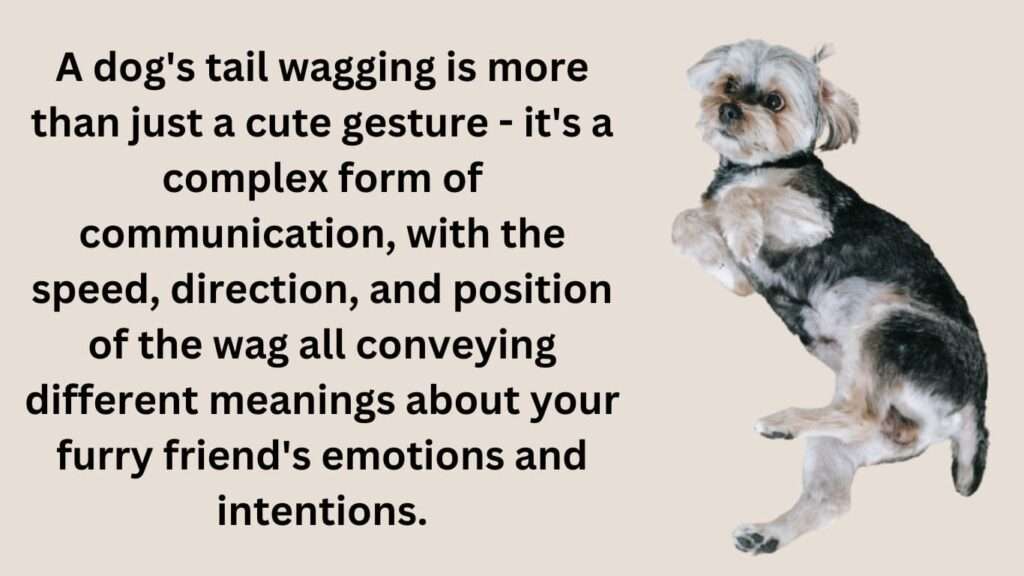
Dogs communicate a wealth of information through their body language, and one of the most recognizable signals is tail wagging.
Here’s a breakdown of what different tail wags might convey:
1- The Happy Wag:
- A broad, sweeping wag with a loose and relaxed tail indicates a happy and contented dog. This is often seen during greetings or playtime.
2- The Anxious Wag:
- A slower wag with a tucked tail may signal anxiety or uncertainty. It’s crucial to observe other body cues to understand the context.
3- The Excited Wag:
- A high, rapid wag typically signifies excitement. This can happen when your dog anticipates something enjoyable, like a walk or a favorite treat.
4- The Submissive Wag:
- A low and slow wag with the body lowered could indicate submission. This is common when meeting new dogs or people.
5- The Alert Wag:
- A stiff, upright tail wag may suggest alertness or arousal. Your dog is paying attention and might be assessing the situation.
Tips for Interpretation:
- Context Matters: Consider the overall situation, including the environment, other dogs, and any recent activities.
- Look for Additional Cues: Combine tail wagging observations with other body language, such as ear position, facial expressions, and body posture.
- Know Your Dog: Each dog is unique, so understanding your pet’s typical behavior provides valuable context for interpreting tail wags.
Summary
Remember, while tail wagging is a significant indicator, it’s only one part of the broader spectrum of canine communication.
Paying attention to these cues helps strengthen the bond between you and your furry friend.
2. Ear Positioning
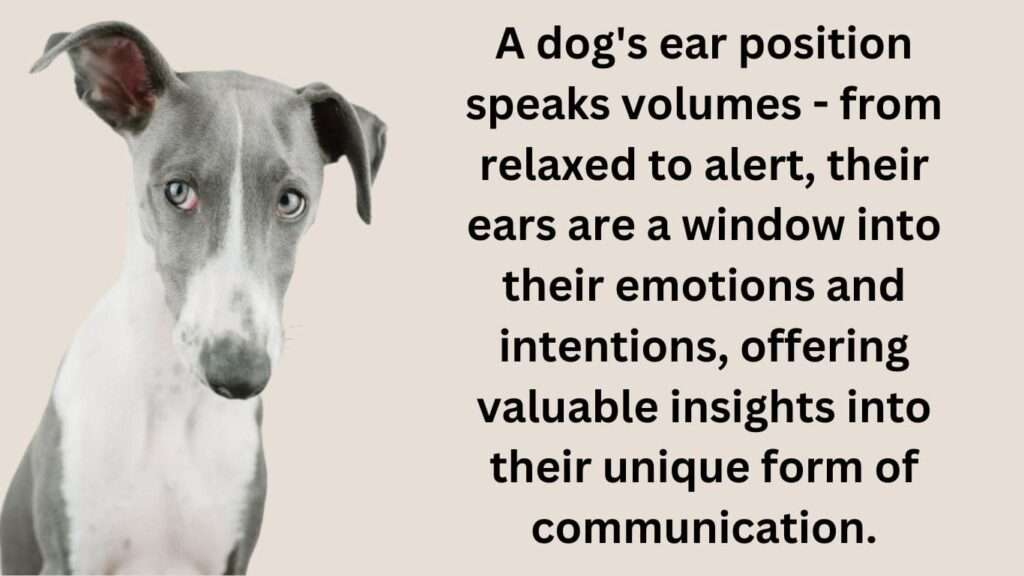
Dogs communicate a wealth of information through their body language, and one key aspect to pay attention to is their ear positioning.
Here’s a guide to understanding what your dog’s ear positions might convey:
1. Forward and Up:
- Indication of Alertness: Ears positioned forward and up suggest that your dog is alert, attentive, and interested in their surroundings.
2. Pinned Back:
- Sign of Fear or Submission: When a dog’s ears are pinned back against the head, it can indicate fear, anxiety, or submission. This posture is often seen in stressful situations.
3. Halfway Back:
- Neutral or Relaxed State: Ears positioned halfway back may signal that your dog is in a neutral or relaxed state. This is common when they’re calm and content.
4. Rotated Outward:
- Friendly and Approachable: Outward-rotated ears can convey friendliness and approachability. Dogs may display this when interacting with familiar people or other dogs.
Flat Against the Head:
- Agitation or Aggression: Ears pressed flat against the head can indicate agitation or aggression. This posture is a warning sign that your dog may feel threatened.
Tips for Interpretation:
- Consider the Context: The context in which you observe your dog’s ear positioning is crucial. Assess the overall situation and surroundings.
- Combine with Other Cues: Pay attention to other body language cues, such as tail wagging, body posture, and facial expressions, to get a comprehensive understanding.
- Know Your Dog’s Normal Behavior: Understanding your individual dog’s typical ear positions in various situations enhances your ability to interpret their feelings.
Summary
By observing and interpreting your dog’s ear positioning, you can gain valuable insights into their emotional state and better respond to their needs.
3. Facial Expressions
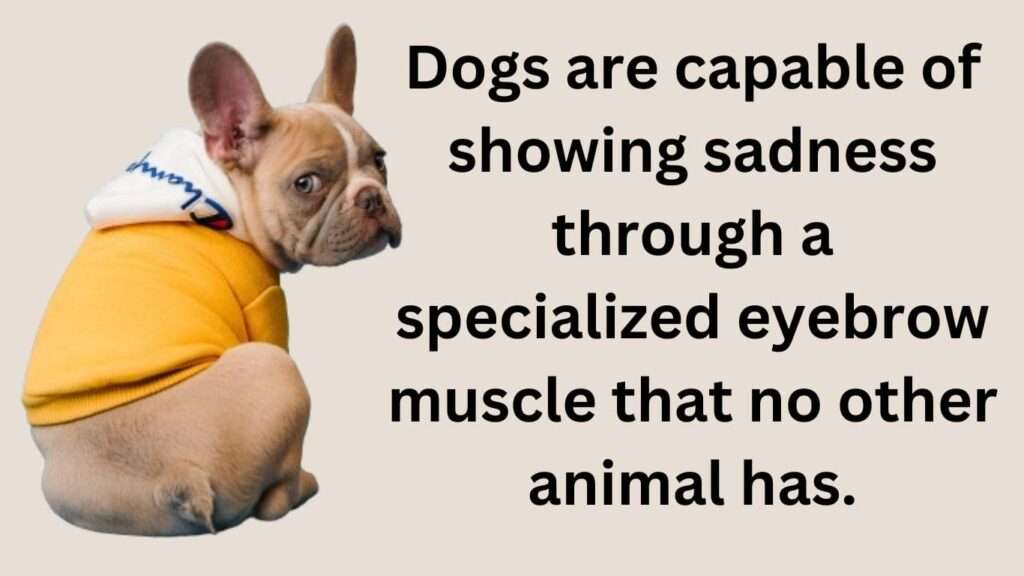
Dogs are masters of non-verbal communication, and their facial expressions convey a multitude of emotions.
Here’s a breakdown of key facial expressions and what they might mean:
1. Relaxed Mouth and Eyes:
- Sign of Contentment: When your dog’s mouth is slightly open, and their eyes are soft, it indicates a relaxed and content state. This is often seen during calm and peaceful moments.
2. Pulled Back Ears with Wrinkled Nose:
- Signal of Fear or Distress: A combination of pulled-back ears and a wrinkled nose can indicate fear or distress. Dogs may display this expression in response to a perceived threat.
3. Bared Teeth with Raised Lips:
- Sign of Aggression: Baring teeth with raised lips is a clear sign of aggression. This expression signals that your dog feels threatened or is asserting dominance.
4. Dilated Pupils and Stiff Facial Muscles:
- Indication of Anxiety or Agitation: Dilated pupils and stiff facial muscles can suggest anxiety or agitation. Dogs may display this expression when faced with unfamiliar or stressful situations.
5. Squinty Eyes and Wagging Tail:
- Expressing Happiness: Squinty eyes, often called “doggy smiles,” accompanied by a wagging tail, are signs of happiness and joy. Dogs display this expression when they’re pleased or excited.
Tips for Interpretation:
- Look at the Whole Face: Consider the overall expression by looking at the eyes, ears, and mouth together for a more accurate interpretation.
- Context Matters: Pay attention to the situation and surroundings to better understand the meaning behind the facial expression.
- Know Your Dog: Understanding your dog’s individual quirks and typical expressions enhances your ability to interpret their emotions.
Summary
By becoming adept at reading your dog’s facial expressions, you can strengthen the bond between you and your furry friend, fostering a deeper understanding of their needs and feelings.
4. Barking Patterns
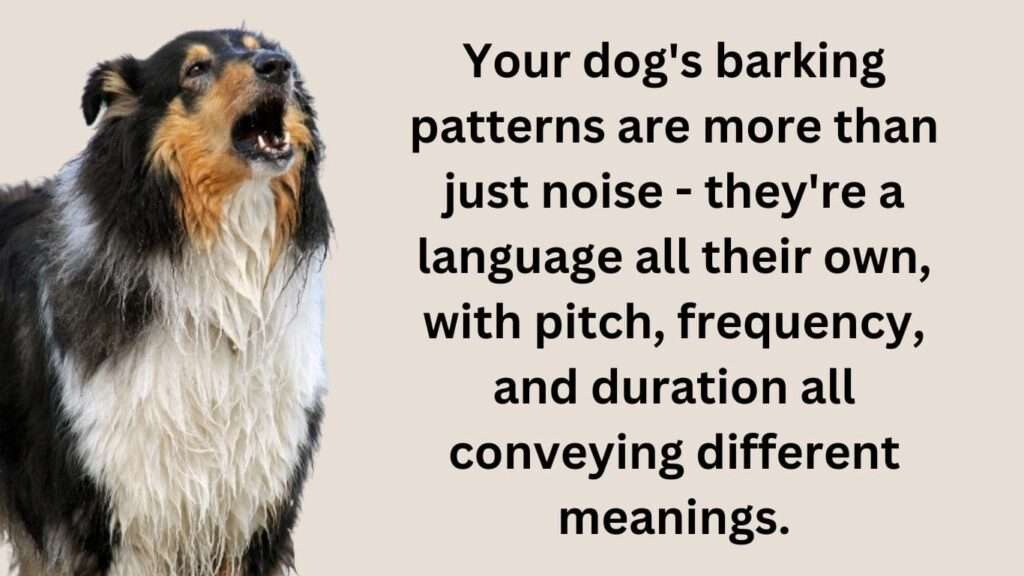
Dogs communicate with us and each other through various barking patterns.
Unravel the mystery behind your dog’s barks with these key insights:
1. Sharp, Short Barks:
- Alerting or Signaling: Quick, sharp barks often indicate your dog is alerting you to something unusual or signaling their presence. This can happen when they hear a noise or detect movement.
2. Rapid Barking in Succession:
- Excitement or Playfulness: A series of rapid barks in quick succession may signify excitement or playfulness. Dogs use this pattern to express their joy during activities they enjoy.
3. Continuous, Monotonous Barking:
- Anxiety or Boredom: Continuous, monotonous barking might suggest your dog is feeling anxious or bored. This is common when they’re left alone for extended periods or lack mental stimulation.
4. High-Pitched, Pleading Barks:
- Seeking Attention or Affection: Dogs may use high-pitched, pleading barks to communicate a desire for attention, affection, or a specific need like going outside.
5. Low, Growling Barks:
- Warning or Threat: Low, growling barks serve as a warning or threat. Your dog may be expressing discomfort or signaling that they perceive a potential threat.
Tips for Interpretation:
- Listen to the Tone: The tone and pitch of the bark provide valuable information about your dog’s emotional state.
- Observe the Context: Consider the situation in which the barking occurs. Is there a specific trigger or stimulus?
- Watch for Other Cues: Combine observations of barking with other body language cues for a more comprehensive understanding.
Summary
Understanding your dog’s barking patterns enhances communication and helps you respond appropriately to their needs, contributing to a harmonious relationship between you and your canine companion.
5. Eye Contact
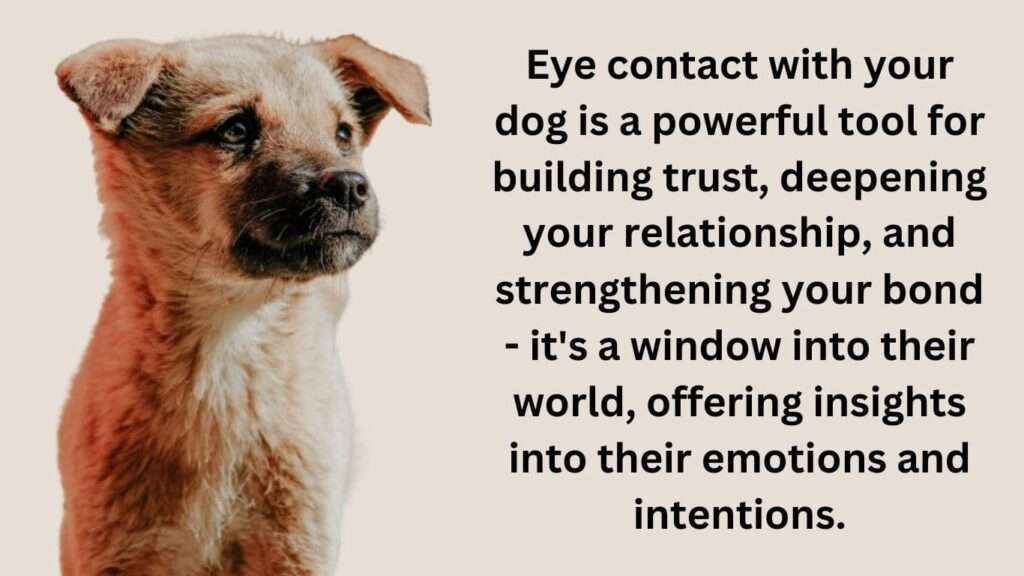
A dog’s eyes speak volumes, conveying a range of emotions and intentions.
Delve into the nuanced language of canine eye contact with these key insights:
1. Soft, Blinking Eyes:
- Expression of Trust: Soft, blinking eyes signify trust and relaxation. When your dog blinks slowly at you, they are expressing comfort and a sense of security.
2. Direct, Staring Eyes:
- Assertiveness or Challenge: A direct, prolonged stare can be an assertive gesture or even a challenge. Dogs may use this to establish dominance or convey confidence.
3. Avoiding Eye Contact:
- Submission or Discomfort: Dogs may avoid direct eye contact as a sign of submission or discomfort. This behavior signals that they acknowledge your authority and pose no threat.
4. Raised Eyebrows:
- Surprise or Curiosity: Raised eyebrows indicate surprise or curiosity. Your dog may use this expression when encountering something new or intriguing.
5. Wide, Dilated Pupils:
- Excitement or Anxiety: Wide, dilated pupils can suggest heightened emotions, whether from excitement or anxiety. Context and other cues help differentiate between positive and negative states.
Tips for Interpretation:
- Consider the Context: Understand the context in which the eye contact occurs to better interpret your dog’s emotions.
- Look at Surrounding Cues: Combine observations of eye contact with other body language cues, such as ear position and tail wagging, for a comprehensive understanding.
- Build Trust: Positive, soft eye contact helps build trust and strengthen the bond between you and your dog.
Summary
By decoding your dog’s eye language, you can foster a deeper connection, respond appropriately to their needs, and ensure a harmonious relationship built on trust and understanding.
6. Body Posture
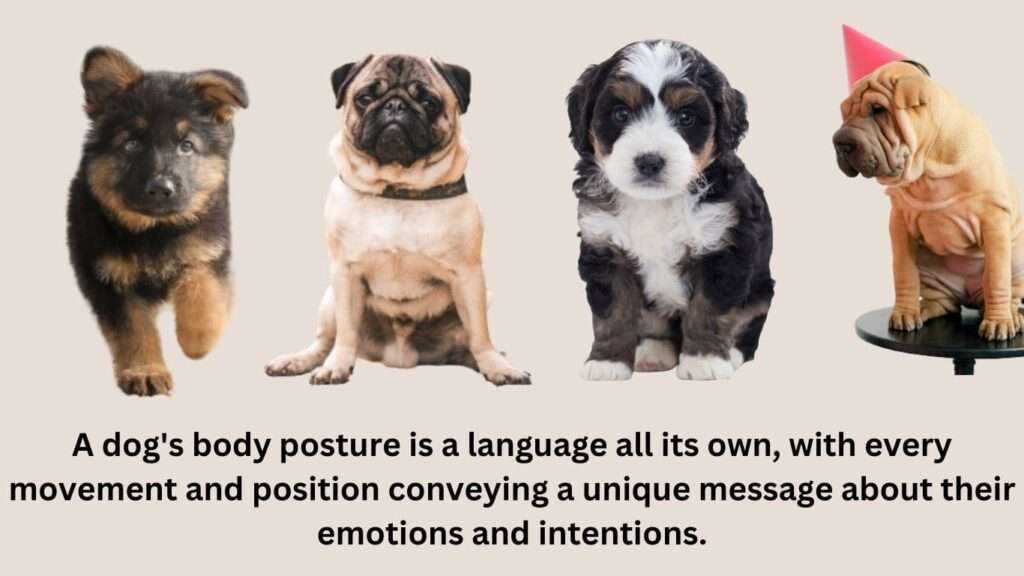
Dogs express a wealth of emotions through their body posture, providing a fascinating insight into their thoughts and feelings.
Decode the language of canine body postures with these key insights:
1. Relaxed and Loose Body:
- Contentment: A dog with a relaxed and loose body is likely feeling content and at ease. This posture is common during restful and comfortable moments.
2. Stiff and Tense Body:
- Alertness or Anxiety: A stiff and tense body suggests heightened alertness or anxiety. Dogs may assume this posture when they sense potential threats or feel uneasy.
3. Arching Back with Raised Fur:
- Agitation or Fear: An arched back with raised fur along the spine indicates agitation or fear. This defensive posture makes the dog appear larger and serves as a warning.
4. Rolling Over:
- Submission or Playfulness: Rolling over, especially exposing the belly, can signal submission or playfulness. It’s a vulnerable position that demonstrates trust.
5. Forward Leaning:
- Anticipation or Eagerness: A dog leaning forward is expressing anticipation or eagerness. This posture often occurs when a dog is excited about something.
Tips for Interpretation:
- Take Note of Tail Position: The position of the tail is a crucial element in understanding body language. Combine observations of body posture with tail cues for a more accurate interpretation.
- Observe Ears and Facial Expressions: Ears and facial expressions provide additional context. For example, forward-leaning ears may indicate curiosity or excitement.
- Consider the Environment: The surroundings and context play a role in interpreting body language. Dogs may react differently in various situations.
Summary
By attuning yourself to your dog’s body posture, you can strengthen your bond, respond appropriately to their needs, and create a harmonious relationship built on understanding and trust.
7. Growling and Snarling
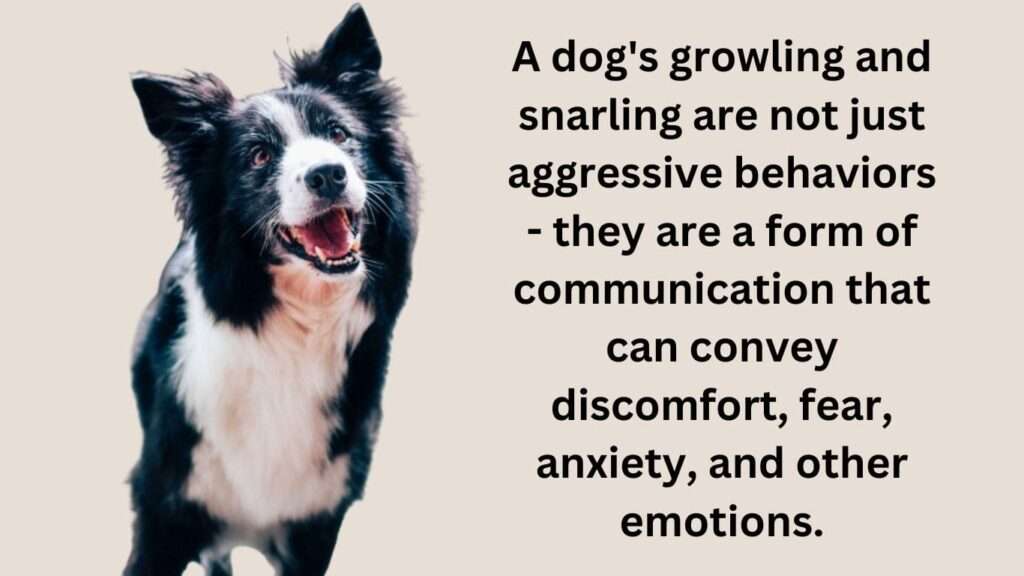
Dogs communicate a range of emotions through vocalizations, and growling and snarling are two distinct expressions.
Uncover the meanings behind these vocal cues with key insights:
- Growling:
- Warning Signal: Growling is often a warning signal, indicating that a dog feels threatened, uncomfortable, or protective. It serves as a communication tool to express displeasure or establish boundaries.
- Snarling:
- Aggression or Fear: Snarling involves showing teeth and often accompanies a more intense display of aggression or fear. It signals that the dog feels cornered, threatened, or is in a confrontational situation.
- Causes of Growling and Snarling:
- Pain or Discomfort: Dogs may growl or snarl when experiencing pain or discomfort. It’s a defensive response to prevent further interaction.
- Territorial Behavior: Protecting their territory is a common trigger for growling and snarling. Dogs may react defensively when they perceive a threat to their space.
- Fear or Anxiety: Growling and snarling can result from fear or anxiety, especially in unfamiliar or stressful situations.
- Context Matters:
- Observe Surroundings: Pay attention to the context in which growling or snarling occurs. Understanding the trigger helps interpret the dog’s emotional state.
- Look for Other Body Language: Combine observations with other body language cues, such as body posture and ear position, to get a comprehensive understanding.
- Seek Professional Guidance:
- Consult a Professional: If your dog consistently displays aggressive behaviors, it’s crucial to seek guidance from a professional dog trainer or behaviorist to address underlying issues.
Summary
Understanding the nuances of growling and snarling enables pet owners to respond appropriately and create a safe and supportive environment for their canine companions.
It’s a vital aspect of promoting positive interactions and ensuring the well-being of both dogs and their human counterparts.
8. Whining and Vocalizations
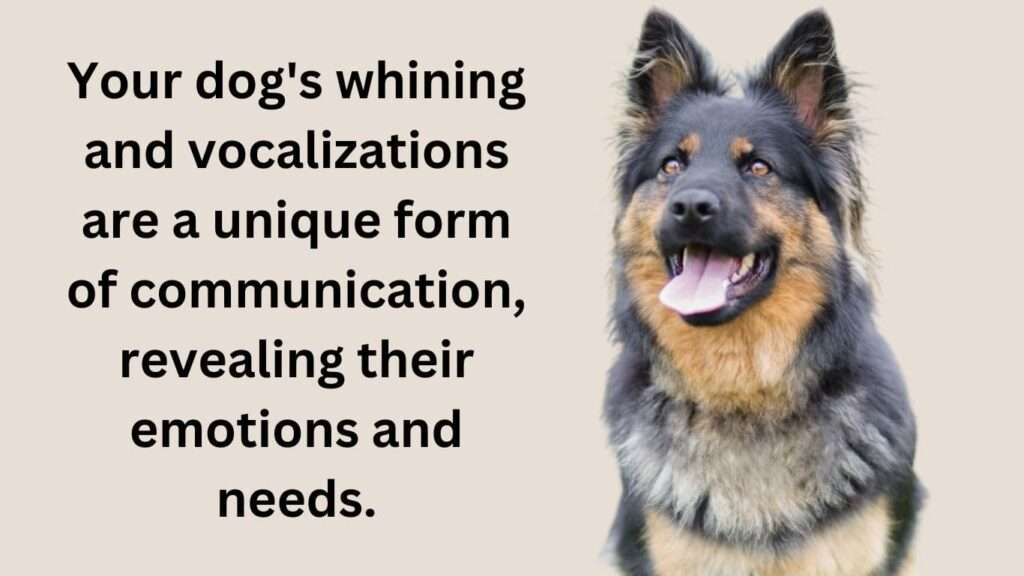
Dogs express themselves through various vocalizations, and whining is a common form of communication.
Explore the meanings behind dog whining and other vocal cues with these key insights:
- Whining:
- Seeking Attention or Comfort: Dogs often whine to get attention, express excitement, or seek comfort. It can indicate a desire for interaction or a response to changes in their environment.
- Howling:
- Communication or Response: Howling is a social behavior that can serve as a form of communication. Dogs may howl in response to sirens, music, or other dogs, expressing their presence or joining in a communal activity.
- Barking:
- Alert or Warning: Barking is a versatile vocalization that can signal alertness, warn of potential threats, or express excitement. Identifying the context helps interpret the specific message.
- Yelping:
- Pain or Distress: Yelping is a sudden, high-pitched sound that indicates pain or distress. It’s a reflexive response to an unexpected sensation, such as a sudden injury.
- Growling:
- Warning or Displeasure: Growling serves as a warning signal, indicating displeasure or discomfort. It’s a vocal cue used to communicate boundaries or express a need for space.
Tips for Interpretation:
- Context Matters: Pay attention to the context in which vocalizations occur. Whether it’s excitement, distress, or communication, context provides valuable insights.
- Observe Body Language: Combine observations of vocalizations with body language cues to better understand your dog’s emotional state.
- Respond Appropriately: Address the underlying cause of vocalizations to ensure your dog’s well-being. Provide comfort, attention, or address potential sources of distress.
Summary
Understanding your dog’s vocal language fosters a stronger bond and enables you to respond appropriately to their needs.
By deciphering the meaning behind whining and other vocalizations, you can enhance communication and create a harmonious relationship with your furry friend.
9. Paw Gestures

Dogs communicate not only through vocalizations but also through subtle paw gestures.
Unravel the meanings behind these paw cues to better understand your furry companion:
1. Paw Lifting:
- Alertness or Curiosity: When a dog lifts its paw, it can signify alertness or curiosity. This gesture often occurs when they encounter something new or interesting.
2. Pawing at Humans:
- Seeking Attention: Dogs may paw at their humans to seek attention, express affection, or communicate a desire for interaction. It’s a common way for them to engage with their human companions.
3. Pawing at Objects:
- Exploration or Playfulness: Pawing at objects, such as toys or the ground, can indicate a playful or exploratory mood. Dogs may engage in this behavior during play or while investigating their surroundings.
4. Offering a Paw:
- Submission or Request: When a dog offers its paw to a human, it can convey a sense of submission or be a request for attention, treats, or affection. It’s a social gesture that strengthens the bond between dog and owner.
5. Holding a Paw Up:
- Pain or Discomfort: If a dog holds a paw up consistently, it may indicate pain or discomfort in that limb. It’s essential to observe for signs of injury or other health issues.
Tips for Interpretation:
- Consider the Context: The context in which paw gestures occur is crucial for interpretation. Whether it’s during play, exploration, or a moment of affection, context provides valuable clues.
- Observe Other Body Language: Combine observations of paw gestures with other body language cues, such as ear position and tail wagging, to gain a more comprehensive understanding.
- Respond Appropriately: Acknowledge and respond to your dog’s paw gestures appropriately. Whether it’s offering a treat, engaging in play, or checking for signs of discomfort, your response strengthens communication.
Summary
By decoding your dog’s paw gestures, you can enhance your connection, respond effectively to their needs, and navigate the rich tapestry of canine communication.
10. Smiling and Panting

Dogs express a range of emotions through body language, and two common cues are smiling and panting.
Dive into the meanings behind these behaviors to decode your dog’s feelings:
1. Smiling:
- Relaxed and Happy
A dog’s “smile” is often characterized by a relaxed face, open mouth, and sometimes visible teeth.
This expression typically indicates a content and happy state. It’s common during moments of relaxation or enjoyment.
2. Panting:
- Cooling Mechanism: Dogs pant to regulate their body temperature. It’s a natural cooling mechanism, especially in warm weather or after physical activity. However, excessive panting, especially without a clear cause, could be a sign of stress, anxiety, or potential health issues.
3. Combination of Smiling and Panting:
- Playfulness and Excitement
When a dog combines smiling with panting, it often signals playfulness and excitement.
This is a common expression during playtime or when anticipating something enjoyable, like a walk or treat.
4. Heavy Panting:
- Stress or Discomfort: Heavy panting, especially when not related to physical exertion, can indicate stress or discomfort. It’s crucial to assess the situation and look for additional cues to determine the cause.
Tips for Interpretation:
- Observe Facial Muscles: A relaxed face with slightly parted lips and a tongue might indicate a genuine doggy smile. Watch for signs of tension or anxiety, such as a tightly closed mouth or wrinkled forehead.
- Consider the Environment: Understanding the context in which these behaviors occur is vital. A smiling, panting dog during play is different from one exhibiting the same signs in a stressful situation.
- Monitor Changes: If your dog’s smiling or panting behavior deviates from the norm, observe for changes in their environment, health, or routine.
Summary
By recognizing the nuances of your dog’s smiling and panting, you’ll deepen your connection and better respond to their emotional needs.
Paying attention to these cues enhances your ability to provide a supportive and comfortable environment for your furry friend.
Bottom Line
In the intricate world of canine communication, understanding your dog’s body language is crucial.
Each cue, from tail wagging to paw gestures, reveals a unique aspect of their emotions.
Pay attention to the subtleties of ear positioning, facial expressions, and barking patterns.
Decode their language through eye contact, body posture, and vocalizations.
Be attuned to the significance of growling, whining, paw gestures, and the nuances of smiling and panting.
By recognizing these cues, you’ll strengthen the bond with your furry friend and navigate the rich tapestry of dog communication with confidence and understanding.
FAQ
What does it mean when a dog wags its tail?
Tail wagging is a versatile form of canine communication.
While a wagging tail is often associated with happiness, it can also convey other emotions.
A loose and wide wag usually signals friendliness, while a stiff or tucked tail may indicate fear or submission.
Additionally, the direction of the wag matters – a wag to the right suggests positive feelings, while a leftward wag can indicate uncertainty or anxiety.
How can I tell if my dog is happy?
A happy dog exhibits various signs, including a relaxed body posture, a wagging tail, and a “smiling” expression.
They may engage in playful behaviors, such as play bows or bringing you toys. A content dog also has soft, relaxed eyes and ears positioned in a natural, upright manner.
Understanding your dog’s normal behavior is key to recognizing when they are in a happy and relaxed state.
Why does my dog smile or show its teeth?
Dogs don’t actually smile in the human sense, but a relaxed, open mouth with exposed teeth can resemble a grin.
This expression often signifies friendliness and comfort.
However, if the teeth are bared and accompanied by growling or tense body language, it can indicate aggression or discomfort.
Context and accompanying body language provide crucial clues to interpret this behavior accurately.
What is the significance of a dog's ear positioning?
A dog’s ear positioning reflects their emotional state.
Erect ears suggest attentiveness or excitement, while flattened ears signal fear or submission.
If your dog’s ears are pulled back tightly against their head, it may indicate stress or anxiety.
Understanding ear movements in conjunction with other body language helps you decipher your dog’s emotions more accurately.
How do I interpret my dog's facial expressions?
Facial expressions, including the eyes, mouth, and overall demeanor, convey a wealth of information about a dog’s emotions.
Soft, relaxed eyes and a slightly open mouth often indicate a calm and content state.
Raised eyebrows can signal curiosity or surprise, while a wrinkled forehead might suggest tension or anxiety.
Learning to read your dog’s face as a whole provides insights into their emotional well-being.
Why does my dog bark in different patterns?
Dogs bark for various reasons, and the pattern can offer clues.
A rapid, high-pitched bark may indicate excitement or playfulness, while a deep, slow bark might signal a perceived threat.
Excessive barking can also result from boredom or anxiety.
Understanding the context, pitch, and frequency of your dog’s barks helps discern their intentions and emotional state.
What does it mean when my dog makes eye contact?
Eye contact can convey different messages depending on the context.
Direct eye contact can be a sign of trust, affection, or a request for attention.
However, prolonged staring, especially if accompanied by tense body language, may signal a challenge or discomfort.
Understanding the nuances of eye contact in various situations helps interpret your dog’s intentions accurately.
How can I tell if my dog is stressed or anxious?
Stress or anxiety in dogs can manifest through various signs, including pacing, excessive panting, drooling, trembling, or avoiding eye contact.
Changes in appetite or behavior, along with destructive tendencies, can also indicate stress.
Recognizing these signs promptly allows you to address the underlying causes and provide comfort and support.
Is panting always a sign of a hot dog?
While dogs pant to cool down, excessive panting isn’t always related to heat. Dogs may pant due to excitement, anxiety, pain, or illness.
If your dog is panting excessively without an apparent reason, it’s essential to consider the overall context and monitor for other signs of discomfort or distress.
Why does my dog use paw gestures, and what do they mean?
Paw gestures serve as a form of communication for dogs.
Your dog may raise a paw to signal friendliness, seek attention, or express submission.
Pawing at you or objects can be a request for interaction or play.
Paying attention to the context and accompanying body language helps decipher the specific message your dog is conveying through their paw gestures.
References For Further Reading
- Dogs’ Body Language Relevant to Learning Achievement
- Better understanding of dog body language could make interactions safer
- How to Speak Dog by Understanding Canine Body Language
- Dog Behavior: Why Dogs Bark
- Why do dogs wag their tails?
- Dogs and humans process body posture and social information in surprisingly similar ways
